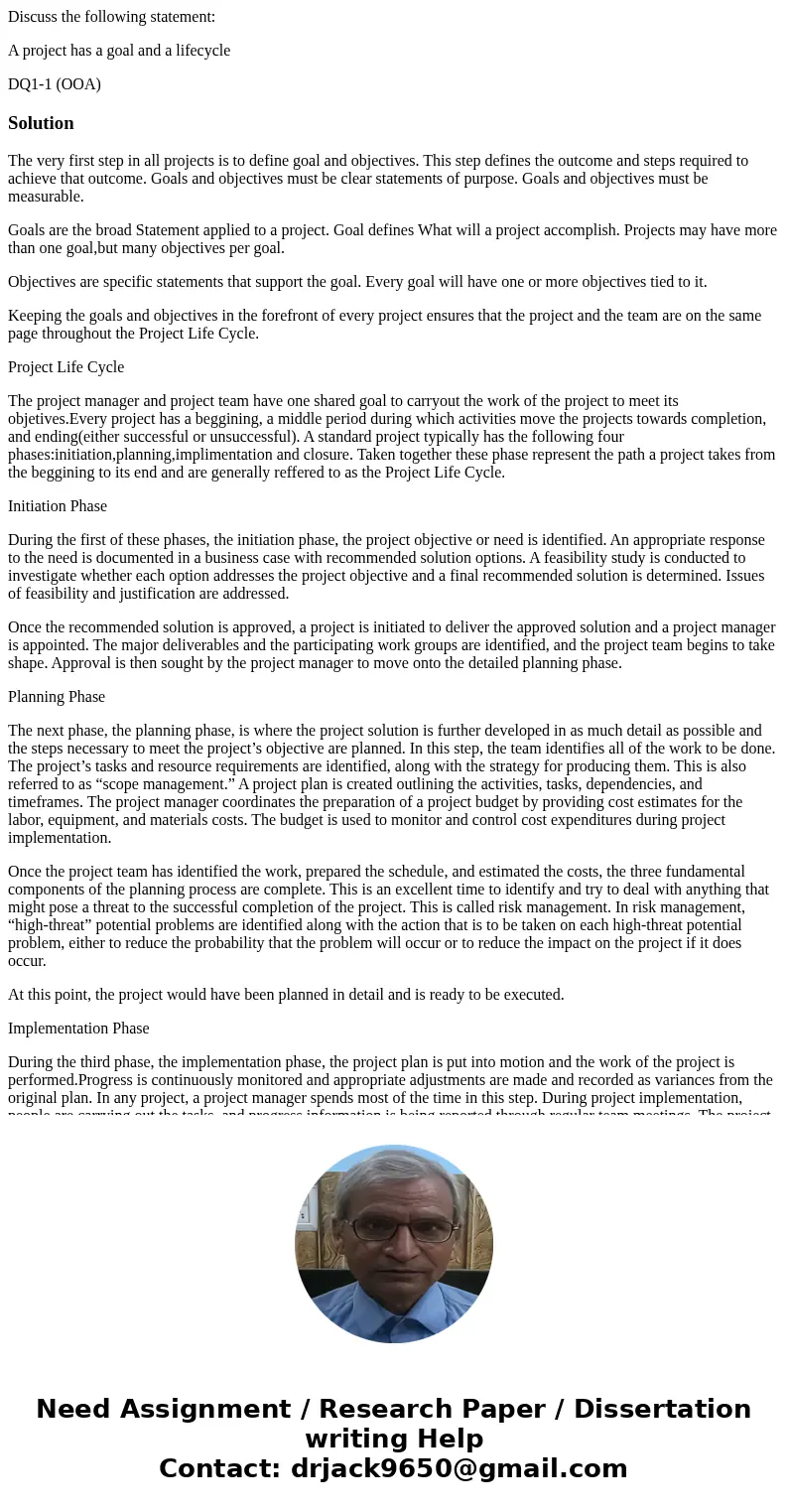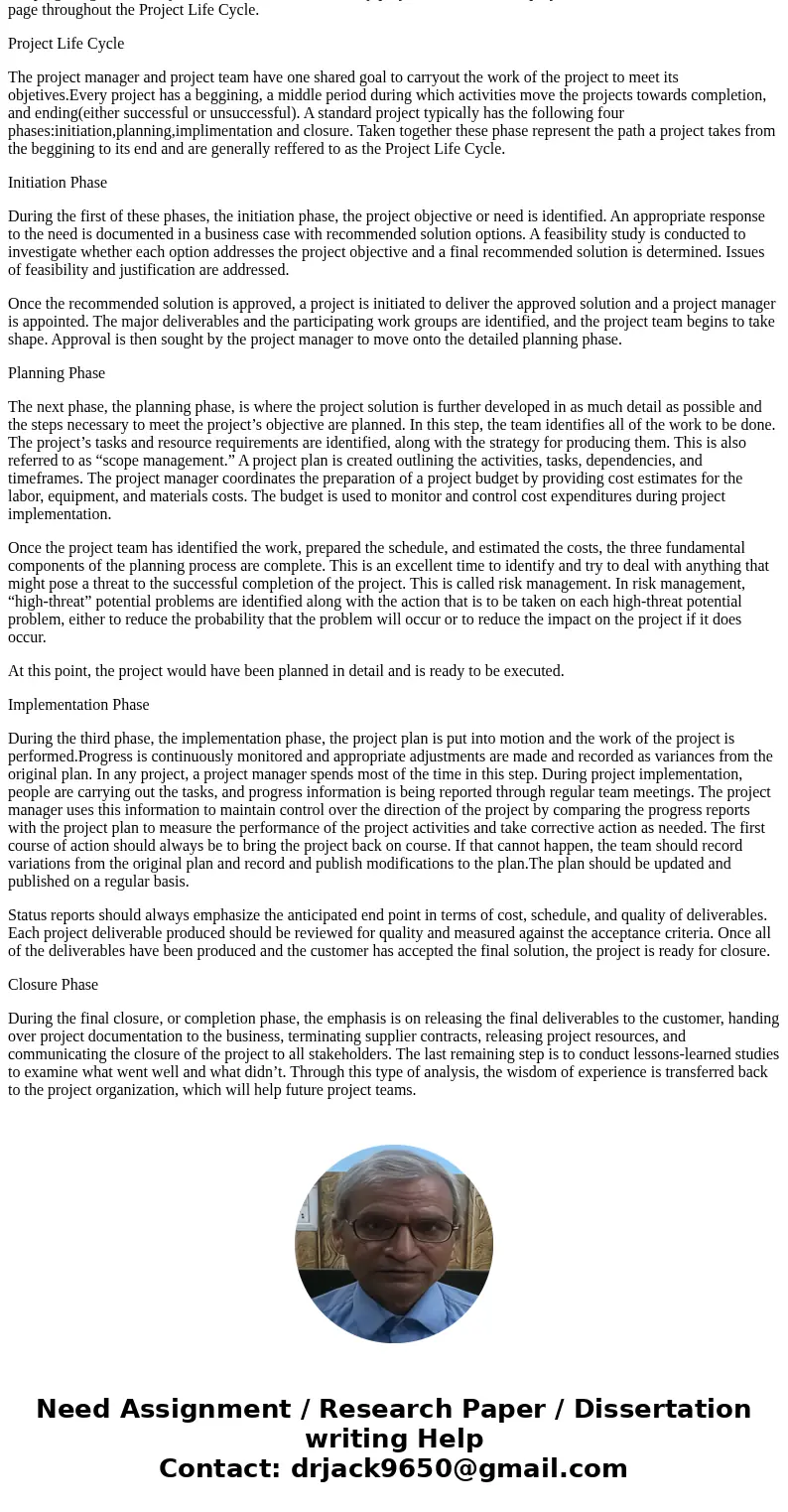Discuss the following statement A project has a goal and a l
Discuss the following statement:
A project has a goal and a lifecycle
DQ1-1 (OOA)
Solution
The very first step in all projects is to define goal and objectives. This step defines the outcome and steps required to achieve that outcome. Goals and objectives must be clear statements of purpose. Goals and objectives must be measurable.
Goals are the broad Statement applied to a project. Goal defines What will a project accomplish. Projects may have more than one goal,but many objectives per goal.
Objectives are specific statements that support the goal. Every goal will have one or more objectives tied to it.
Keeping the goals and objectives in the forefront of every project ensures that the project and the team are on the same page throughout the Project Life Cycle.
Project Life Cycle
The project manager and project team have one shared goal to carryout the work of the project to meet its objetives.Every project has a beggining, a middle period during which activities move the projects towards completion, and ending(either successful or unsuccessful). A standard project typically has the following four phases:initiation,planning,implimentation and closure. Taken together these phase represent the path a project takes from the beggining to its end and are generally reffered to as the Project Life Cycle.
Initiation Phase
During the first of these phases, the initiation phase, the project objective or need is identified. An appropriate response to the need is documented in a business case with recommended solution options. A feasibility study is conducted to investigate whether each option addresses the project objective and a final recommended solution is determined. Issues of feasibility and justification are addressed.
Once the recommended solution is approved, a project is initiated to deliver the approved solution and a project manager is appointed. The major deliverables and the participating work groups are identified, and the project team begins to take shape. Approval is then sought by the project manager to move onto the detailed planning phase.
Planning Phase
The next phase, the planning phase, is where the project solution is further developed in as much detail as possible and the steps necessary to meet the project’s objective are planned. In this step, the team identifies all of the work to be done. The project’s tasks and resource requirements are identified, along with the strategy for producing them. This is also referred to as “scope management.” A project plan is created outlining the activities, tasks, dependencies, and timeframes. The project manager coordinates the preparation of a project budget by providing cost estimates for the labor, equipment, and materials costs. The budget is used to monitor and control cost expenditures during project implementation.
Once the project team has identified the work, prepared the schedule, and estimated the costs, the three fundamental components of the planning process are complete. This is an excellent time to identify and try to deal with anything that might pose a threat to the successful completion of the project. This is called risk management. In risk management, “high-threat” potential problems are identified along with the action that is to be taken on each high-threat potential problem, either to reduce the probability that the problem will occur or to reduce the impact on the project if it does occur.
At this point, the project would have been planned in detail and is ready to be executed.
Implementation Phase
During the third phase, the implementation phase, the project plan is put into motion and the work of the project is performed.Progress is continuously monitored and appropriate adjustments are made and recorded as variances from the original plan. In any project, a project manager spends most of the time in this step. During project implementation, people are carrying out the tasks, and progress information is being reported through regular team meetings. The project manager uses this information to maintain control over the direction of the project by comparing the progress reports with the project plan to measure the performance of the project activities and take corrective action as needed. The first course of action should always be to bring the project back on course. If that cannot happen, the team should record variations from the original plan and record and publish modifications to the plan.The plan should be updated and published on a regular basis.
Status reports should always emphasize the anticipated end point in terms of cost, schedule, and quality of deliverables. Each project deliverable produced should be reviewed for quality and measured against the acceptance criteria. Once all of the deliverables have been produced and the customer has accepted the final solution, the project is ready for closure.
Closure Phase
During the final closure, or completion phase, the emphasis is on releasing the final deliverables to the customer, handing over project documentation to the business, terminating supplier contracts, releasing project resources, and communicating the closure of the project to all stakeholders. The last remaining step is to conduct lessons-learned studies to examine what went well and what didn’t. Through this type of analysis, the wisdom of experience is transferred back to the project organization, which will help future project teams.


 Homework Sourse
Homework Sourse